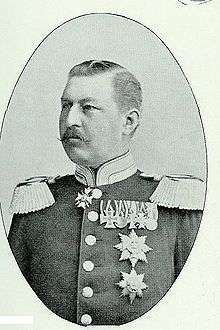Schwarzburg-Rudolstadt
Schwarzburg-Rudolstadt was a small historic state in present-day Thuringia, Germany with its capital at Rudolstadt.
History
Schwarzburg-Rudolstadt was established in 1599 in the course of a resettlement of Schwarzburg dynasty lands. Since the 11th century, the ancestral seat of the comital family had been at Schwarzburg Castle, though after 1340, for most of its existence as a polity had the capital at the larger town of Rudolstadt. In 1583 Count Günther XLI of Schwarzburg, the eldest son of Günther XL the Rich and ruler over the united Schwarzburg lands, had died without issue. He was succeeded by his younger brothers, whereby Albert VII received the territory around Rudolstadt. After their brother Count William of Schwarzburg-Frankenhausen had died in 1597, the surviving brothers Albert VII and John Günther I established the two counties of Schwarzburg-Rudolstadt and Schwarzburg-Sondershausen by the 1599 Treaty of Stadtilm.
Albert's descendants ruled as sovereign counts of the Holy Roman Empire. Count Albert Anton (1662–1710) was elevated to the rank of a Prince by Emperor Leopold I of Habsburg, it was however his son Louis Frederick I (1710–1718) who first bore the princely title, whereby Schwarzburg-Rudolstadt in 1711 became a principality under the same entity. It withstood the mediatisation and after the Empire's dissolution joined the Confederation of the Rhine in 1807 and the German Confederation in 1815.
On 23 November 1918, during the German Revolution of 1918–1919 and the fall of all the German monarchies, Prince Günther Victor was the last to abdicate. The former principality became a "Free State" in 1919, that was merged into the new state of Thuringia in the next year. In 1905 Schwarzburg-Rudolstadt had an area of 940 km2 (360 sq mi) and a population of 97,000.
Rulers of Schwarzburg-Rudolstadt

Aerial view at Schwarzburg
Counts of Schwarzburg-Rudolstadt
Princes of Schwarzburg-Rudolstadt
Heads of the princely house of Schwarzburg post-monarchy
On the death of the childless Prince Günther Victor in 1925 he was succeeded by Prince Sizzo (1860–1926) who was the son of Prince Frederick Günther (1793–1867) from his second, morganatic marriage. Prince Sizzo was recognised as a full member of the House of Schwarzburg in 1896. Upon the death of Prince Friedrich Günther, the last in the male line, the headship passed under Semi-Salic primogeniture to his elder sister, Princess Marie Antoinette of Schwarzburg who married Friedrich Magnus V, Count of Solms-Wildenfels. The House of Schwarzburg subsequently became a personal union with the House of Solms-Wildenfels.[1][2]
See also
References
External links
|
|---|
| Rank elevated
by Napoleon | Kingdoms | |
|---|
| Grand Duchies | |
|---|
| Duchies | |
|---|
| |
|---|
| | States created | Kingdoms | |
|---|
| Grand Duchies | |
|---|
| Principalities | |
|---|
|
|---|
| Pre-existing
states | | |
|---|
| Other duchies | |
|---|
| Principalities | |
|---|
|
|---|
|
- 1 from 1810
- 2 until 1810
- 3 until 1809
- 4 from 1809
- 5 until 1811
|
|
|
|---|
| | Empires | | |
|---|
| | Kingdoms | |
|---|
| | Electorates | |
|---|
| | Grand Duchies | |
|---|
| | Duchies | |
|---|
| | Principalities | |
|---|
| | City-states | |
|---|
| | Unrecognized | |
|---|
|
- 1 w/o areas listed under other territories
- 2 Merged with Anhalt from 1863
- 3 until 1847
- 4 from 1839
- 5 from 1826
- 6 until 1826
- 7 until 1850
- 8 1849–60
- 9 as of 1849
- 10 until 1837
- 11 until 1829
- 12 until 1848/57
- 13 until 1848
- 14 as of 1848
- 15 as of 1829
- 16 as of 1864
|
|
.svg.png)





 Chisholm, Hugh, ed. (1911). "Schwarzburg-Rudolstadt". Encyclopædia Britannica (11th ed.). Cambridge University Press.
Chisholm, Hugh, ed. (1911). "Schwarzburg-Rudolstadt". Encyclopædia Britannica (11th ed.). Cambridge University Press.





-de.svg.png)
